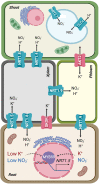Coordinated Transport of Nitrate, Potassium, and Sodium
- PMID: 32211003
- PMCID: PMC7067972
- DOI: 10.3389/fpls.2020.00247
Coordinated Transport of Nitrate, Potassium, and Sodium
Abstract
Potassium (K+) and nitrogen (N) are essential nutrients, and their absorption and distribution within the plant must be coordinated for optimal growth and development. Potassium is involved in charge balance of inorganic and organic anions and macromolecules, control of membrane electrical potential, pH homeostasis and the regulation of cell osmotic pressure, whereas nitrogen is an essential component of amino acids, proteins, and nucleic acids. Nitrate (NO3 -) is often the primary nitrogen source, but it also serves as a signaling molecule to the plant. Nitrate regulates root architecture, stimulates shoot growth, delays flowering, regulates abscisic acid-independent stomata opening, and relieves seed dormancy. Plants can sense K+/NO3 - levels in soils and adjust accordingly the uptake and root-to-shoot transport to balance the distribution of these ions between organs. On the other hand, in small amounts sodium (Na+) is categorized as a "beneficial element" for plants, mainly as a "cheap" osmolyte. However, at high concentrations in the soil, Na+ can inhibit various physiological processes impairing plant growth. Hence, plants have developed specific mechanisms to transport, sense, and respond to a variety of Na+ conditions. Sodium is taken up by many K+ transporters, and a large proportion of Na+ ions accumulated in shoots appear to be loaded into the xylem by systems that show nitrate dependence. Thus, an adequate supply of mineral nutrients is paramount to reduce the noxious effects of salts and to sustain crop productivity under salt stress. In this review, we will focus on recent research unraveling the mechanisms that coordinate the K+-NO3 -; Na+-NO3 -, and K+-Na+ transports, and the regulators controlling their uptake and allocation.
Keywords: long-distance transport; nitrate; plant nutrition; potassium; salinity; sodium.
Copyright © 2020 Raddatz, Morales de los Ríos, Lindahl, Quintero and Pardo.
Figures




References
-
- Aleman F., Nieves-Cordones M., Martinez V., Rubio F. (2009). Differential regulation of the HAK5 genes encoding the high-affinity K(+) transporters of Thellungiella halophila and Arabidopsis thaliana. Environ. Exp. Bot. 65 263–269. 10.1016/j.envexpbot.2008.09.011 - DOI

